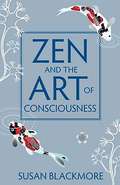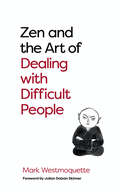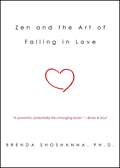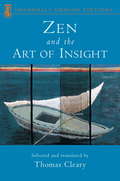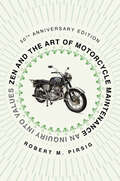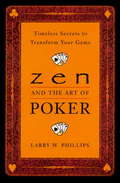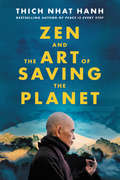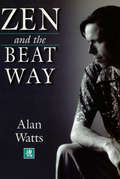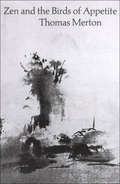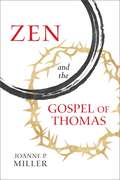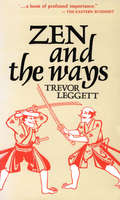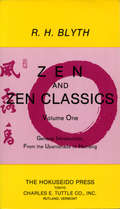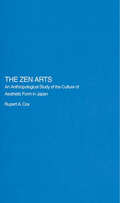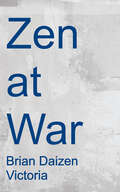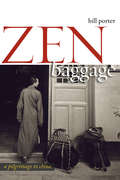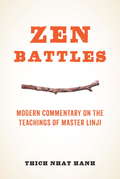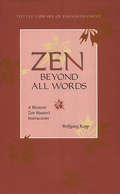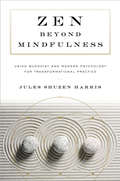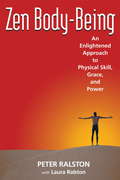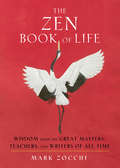- Table View
- List View
Zen and the Art of Consciousness
by Susan BlackmoreWho are you? When are you? What were you conscious of a moment ago? This groundbreaking book sees acclaimed psychologist Susan Blackmore combining the latest scientific theories about mind, self, and consciousness with a lifetime's practice of Zen. Framed by ten critical questions derived from Zen teachings and designed to expand your understanding and experience of consciousness, Ten Zen Questions doesn't offer final - or easy - answers, but instead provides an inspiring exploration of how intellectual enquiry and meditation can tackle some of today's greatest scientific mysteries. Dr Susan Blackmore is a writer and broadcaster. She lives in Bristol, UK.
Zen and the Art of Dealing with Difficult People
by Mark WestmoquetteThis is a unique guide to coping with challenging people using practical Zen and mindfulness tools. It helps readers explore their reactions, break free from knee-jerk response patterns and see if these people may in fact prove to be useful teachers in life – troublesome Buddhas.This is a guide to applying the teachings of mindfulness and Zen to the troublesome or challenging people in our lives. Perhaps you can see there&’s often a pattern to your behaviour in relation to them and that it often causes pain – perhaps a great deal of pain. The only way we can grow is by facing this pain, acknowledging how we feel and how we&’ve reacted, and making an intention or commitment to end this repeating pattern of suffering. In this book, Mark Westmoquette speaks from a place of profound personal experience. A Zen monk, he has endured two life-changing traumas caused by other people: his sexual abuse by his own father; and his stepfather&’s death and mother&’s very serious injury in a car crash due to the careless driving of an off-duty policeman. He stresses that by bringing awareness and kindness to these relationships, our initial stance of &“I can&’t stand this person, they need to change&” will naturally shift into something much broader and more inclusive. The book makes playful use of Zen koans – apparently nonsensical phrases or stories – to help jar us out of habitual ways of perceiving the world and nudge us toward a new perspective of wisdom and compassion.
Zen and the Art of Falling in Love
by Dr. Brenda ShoshannaPerennially popular topics Zen and romance come together in this unique guide that reveals how to fall in love and stay that way.We are meant to be in love. Love energizes our daily existence, heals the body and mind and makes every moment precious. So why aren't we in love all the time? In Zen and the Art of Falling in Love, psychologist, relationship expert and Zen practitioner Brenda Shoshanna shows readers how to rejuvenate their romantic lives by combining a psychological understanding of relationships with the way of Zen practice. The lessons provided by such practices as Taking Your Shoes Off (Becoming Available), Sitting on the Cushion (Meeting Yourself), Cleaning House (Emptying Yourself) and Receiving the Stick (Dealing with Blows) can offer new insight into the common problems of miscommunication, lies, betrayal, jealousy, insecurity, loss, and disappointment. Using the lessons of Zen practice, you can open your life to love, fall in love—and stay in love.
Zen and the Art of Insight
by Thomas ClearyThe Prajnaparamita ("perfection of wisdom") sutras are one of the great legacies of Mahayana Buddhism, giving eloquent expression to some of that school's central concerns: the perception of shunyata, the essential emptiness of all phenomena; and the ideal of the bodhisattva, one who postpones his or her own enlightenment in order to work for the salvation of all beings. The Prajnaparamita literature consists of a number of texts composed in Buddhist India between 100 BCE and 100 CE. Originally written in Sanskrit, but surviving today mostly in their Chinese versions, the texts are concerned with the experience of profound insight that cannot be conveyed by concepts or in intellectual terms. The material remains important today in Mahayana Buddhism and Zen. Key selections from the Prajnaparamita literature are presented here, along with Thomas Cleary's illuminating commentary, as a means of demonstrating the intrinsic limitations of discursive thought, and of pointing to the profound wisdom that lies beyond it. Included are selections from: * The Scripture on Perfect Insight Awakening to Essence * The Essentials of the Great Scripture on Perfect Insight * Treatise on the Great Scripture on Perfect Insight * The Scripture on Perfect Insight for Benevolent Rulers * Key Teachings on the Great Scripture of Perfect Insight * The Questions of Suvikrantavikramin
Zen and the Art of Motorcycle Maintenance: An Inquiry Into Values (Perennial Classics Ser.)
by Robert M PirsigTHE CLASSIC BOOK THAT HAS INSPIRED MILLIONSA penetrating examination of how we live and how to live betterFew books transform a generation and then establish themselves as touchstones for the generations that follow. Zen and the Art of Motorcycle Maintenance is one such book. This modern epic of a man’s search for meaning became an instant bestseller on publication in 1974, acclaimed as one of the most exciting books in the history of American letters. It continues to inspire millions. A narration of a summer motorcycle trip undertaken by a father and his son, Zen and the Art of Motorcycle Maintenance becomes a personal and philosophical odyssey into fundamental questions on how to live. The narrator's relationship with his son leads to a powerful self-reckoning; the craft of motorcycle maintenance leads to an austerely beautiful process for reconciling science, religion, and humanism. Resonant with the confusions of existence, this classic is a touching and transcendent book of life.This new edition contains an interview with Pirsig and letters and documents detailing how this extraordinary book came to be.
Zen and the Art of Poker: Timeless Secrets to Transform Your Game
by Larry PhillipsInside the intriguing world of poker lies a fascinating exercise in strategy and extreme concentration--many of the same principles that underpin the one-thousand-year-old philosophy of Zen spirituality. Zen and the Art of Poker is the first book to apply Zen theories to America's most popular card game, presenting tips that readers can use to enhance their game. Among the more than one hundred rules that comprise this book, readers will learn to:* Make peace with folding* Use inaction as a weapon* Make patience a central pillar of their strategy* Pick their times of confrontationUsing a concise and spare style, in the tradition of Zen practices and rituals, Zen and the Art of Poker traces a parallel track connecting the two disciplines by giving comments and inspirational examples from the ancient Zen masters to the poker masters of today.
Zen and the Art of Saving the Planet
by Thich Nhat Hanh“When you wake up and you see that the Earth is not just the environment, the Earth is us, you touch the nature of interbeing. And at that moment you can have real communication with the Earth… We have to wake up together. And if we wake up together, then we have a chance. Our way of living our life and planning our future has led us into this situation. And now we need to look deeply to find a way out, not only as individuals, but as a collective, a species.”-- Thich Nhat HanhWe face a potent intersection of crises: ecological destruction, rising inequality, racial injustice, and the lasting impacts of a devastating pandemic. The situation is beyond urgent. To face these challenges, we need to find ways to strengthen our clarity, compassion, and courage to act.Beloved Zen Master Thich Nhat Hanh is blazingly clear: there’s one thing we all have the power to change, which can make all the difference, and that is our mind. Our way of looking, seeing, and thinking determines every choice we make, the everyday actions we take or avoid, how we relate to those we love or oppose, and how we react in a crisis.Mindfulness and the radical insights of Zen meditation can give us the strength and clarity we need to help create a regenerative world in which all life is respected. Filled with Thich Nhat Hanh’s inspiring meditations, Zen stories and experiences from his own activism, as well as commentary from Sister True Dedication, one of his students Zen and the Art of Saving the Planet shows us a new way of seeing and living that can bring healing and harmony to ourselves, our relationships, and the Earth.
Zen and the Beat Way
by Alan WattsZen and the Beat Way is based upon selections from Alan Watts's early radio talks, many of which were first aired on the Pacifica Radio Network in the late fifties and early sixties, and sessions from two of his most compelling seminarsin the mid-sixties.
Zen and the Birds of Appetite
by Thomas Merton"Zen enriches no one," Thomas Merton provocatively writes in his opening statement to Zen and the Birds of Appetite--one of the last books to be published before his death in 1968. "There is no body to be found. The birds may come and circle for a while. . . but they soon go elsewhere. When they are gone, the 'nothing,' the 'no-body' that was there, suddenly appears. That is Zen. It was there all the time but the scavengers missed it, because it was not their kind of prey. " This gets at the humor, paradox, and joy that one feels in Merton's discoveries of Zen during the last years of his life, a joy very much present in this collection of essays. Exploring the relationship between Christianity and Zen, especially through his dialogue with the great Zen teacher D. T. Suzuki, the book makes an excellent introduction to a comparative study of these two traditions, as well as giving the reader a strong taste of the mature Merton. Never does one feel him losing his own faith in these pages; rather one feels that faith getting deeply clarified and affirmed. Just as the body of "Zen" cannot be found by the scavengers, so too, Merton suggests, with the eternal truth of Christ.
Zen and the Gospel of Thomas
by Joanne P. MillerZen and the Gospel of Thomas illuminates sacred, mysterious wisdom from two traditions, revealing how these profound teachings apply to our everyday life and spiritual practice.Imagine that the Buddha asked Jesus to write a text for a Zen audience that would explain his take on the mysteries of his Kingdom. Imagine also that Jesus chose to present it in a set of short koanlike sayings similar to the classic koan collections of the Zen tradition. This is, in essence, the gnostic Gospel of Thomas. A Zen reading of Thomas allows us to access the living Jesus through Buddhist eyes so we can add to and refine our own practice with his wisdom. Likewise, Thomas can be a gateway for Christians to make use of Zen. Like the Buddha, this Jesus of Thomas wishes us to realize, individually and personally, the truth of the eternal. He offers teachings for the whole of our lives, dealing with such topics as: the proper use of money; how to foster wisdom and insight; the nature of awakening and non-attachment; love and judgment; how to rest in the essential; and the nature of what it means to be an enlightened person. Like koans, the sayings in the Gospel of Thomas ask each of us to discover the same secrets of mystery that Jesus himself discovered and to live out that knowledge in our own unique way.
Zen and the Unspeakable God: Comparative Interpretations of Mystical Experience
by Jason N. BlumZen and the Unspeakable God reevaluates how we study mystical experience. Forsaking the prescriptive epistemological box that has constrained the conversation for decades, ensuring that methodology has overshadowed subject matter, Jason Blum proposes a new interpretive approach—one that begins with a mystic’s own beliefs about the nature of mystical experience. Blum brings this approach to bear on the experiential accounts of three mystical exemplars: Meister Eckhart, Ibn al-ʿArabi, and Hui-neng. Through close readings of their texts, he uncovers the mystics’ own fundamental assumptions about transcendence and harnesses these as interpretive guides to their experiences.The predominant theory-first path to interpretation has led to the misunderstanding and misrepresentation of individual mystical experiences and fostered specious conclusions about cross-cultural comparability among them. Blum’s hermeneutic invites the scholarly community to begin thinking about mystical experience in a new way—through the mystics’ eyes. Zen and the Unspeakable God offers a sampling of the provocative results of this technique and an explanation of its implications for theories of consciousness and our contemporary understanding of the nature of mystical experience.
Zen and the Ways
by Trevor LeggettExpression of Zen inspiration in everyday activities such as writing or serving tea, and in knightly arts such as fencing, came to be highly regarded in Japanese tradition. In the end, some of them were practiced as spiritual training in themselves; they were then called " Ways. " This book includes translations of some rare texts on Zen and the Ways. One is a sixteenth century Zen text compiled from Kamakura temple records of the previous three centuries, giving accounts of the very first Zen interviews in Japan . It gives the actual koan "test questions" which disciples had to answer. In the koan called Sermon, " for instance, among the tests are: How would you give a sermon to a one-month-old child? To someone screaming with pain in hell? To a foreign pirate who cannot speak your language? To Maitreya in the Tushita heaven? Extracts are translated from the "secret scrolls" of fencing, archery, judo, and so on. These scrolls were given in feudal days to pupils when they graduated from the academy, and some of them contain profound psychological and spiritual hints, but in deliberately cryptic form. They cannot be understood without long experience as a student of a Way, and the author draws on over forty years' experience as a student and later as a teacher of the Way called judo. The text is accompanied by exquisite line drawings and plates.
Zen and the Ways
by Trevor LeggettExpression of Zen inspiration in everyday activities such as writing or serving tea, and in knightly arts such as fencing, came to be highly regarded in Japanese tradition. In the end, some of them were practiced as spiritual training in themselves; they were then called " Ways. " This book includes translations of some rare texts on Zen and the Ways. One is a sixteenth century Zen text compiled from Kamakura temple records of the previous three centuries, giving accounts of the very first Zen interviews in Japan . It gives the actual koan "test questions" which disciples had to answer. In the koan called Sermon, " for instance, among the tests are: How would you give a sermon to a one-month-old child? To someone screaming with pain in hell? To a foreign pirate who cannot speak your language? To Maitreya in the Tushita heaven? Extracts are translated from the "secret scrolls" of fencing, archery, judo, and so on. These scrolls were given in feudal days to pupils when they graduated from the academy, and some of them contain profound psychological and spiritual hints, but in deliberately cryptic form. They cannot be understood without long experience as a student of a Way, and the author draws on over forty years' experience as a student and later as a teacher of the Way called judo. The text is accompanied by exquisite line drawings and plates.
Zen and Zen Classics volume 1: From the Upanishads to Huineng
by R. H. BlythThis is not a dry scholarly book on Zen. It is a fascinating introduction into a study of self-enlightenment and inner reason that has been a driving force of all Japanese culture. Written by Reginal Horace Blyth (1898-1964) this is a volume free of the dry pedantry that has hobbled so many well meaning French and English studies of Zen. It is free also of the breathless mystery-mongering that unfortunately has bloated American Zen.Blyth reads easily. The questions he poses; the views he offers....all lead to a sense of inner self and an awakening of an awareness of the surrounding universe and one's relationship to it.After discussing "What is Zen?" (and what isn't) Blyth sketches a history of Zen dating from 1000 B.C. to715 A.D., the year of the death of the Sixth patriarch, Huineg. With a historical background thus established, Blyth next provides translations and commentary on some of the most important and basic Zen literature in existence. For the Zen initiate then, this book is an excellent beginning. For the practitioner, further meaningful revelations await.
Zen and Zen Classics volume 1
by R. H. BlythThis is not a dry scholarly book on Zen.It is a fascinating introduction into a study of self-enlightenment and inner reason that has been a driving force of all Japanese culture. Written by Reginal Horace Blyth (1898-1964) this is a volume free of the dry pedantry that has hobbled so many well meaning French and English studies of Zen. It is free also of the breathless mystery-mongering that unfortunately has bloated American Zen.Blyth reads easily. The questions he poses; the views he offers....all lead to a sense of inner self and an awakening ofan awareness of the surrounding universe and one's relationshipto it.After discussing "What is Zen?" (and what isn't) Blyth sketches a history of Zen dating from 1000 B.C. to715A.D., the year of the death of the Sixth Patriarch, Huineg. With a historical background thus established, Blyth next providestranslations and commentary on some of the most important and basic Zen literature in existence. For the Zen initiate then, this book is an excellent beginning. For the practitioner, further meaningful revelations await.
Zen and Zen Classics volume 1
by R. H. BlythThis is not a dry scholarly book on Zen.It is a fascinating introduction into a study of self-enlightenment and inner reason that has been a driving force of all Japanese culture. Written by Reginal Horace Blyth (1898-1964) this is a volume free of the dry pedantry that has hobbled so many well meaning French and English studies of Zen. It is free also of the breathless mystery-mongering that unfortunately has bloated American Zen.Blyth reads easily. The questions he poses; the views he offers....all lead to a sense of inner self and an awakening ofan awareness of the surrounding universe and one's relationshipto it.After discussing "What is Zen?" (and what isn't) Blyth sketches a history of Zen dating from 1000 B.C. to715A.D., the year of the death of the Sixth Patriarch, Huineg. With a historical background thus established, Blyth next providestranslations and commentary on some of the most important and basic Zen literature in existence. For the Zen initiate then, this book is an excellent beginning. For the practitioner, further meaningful revelations await.
The Zen Arts: An Anthropological Study of the Culture of Aesthetic Form in Japan (Royal Asiatic Society Books)
by Rupert CoxThe tea ceremony and the martial arts are intimately linked in the popular and historical imagination with Zen Buddhism, and Japanese culture. They are commonly interpreted as religio-aesthetic pursuits which express core spiritual values through bodily gesture and the creation of highly valued objects. Ideally, the experience of practising the Zen arts culminates in enlightenment.This book challenges that long-held view and proposes that the Zen arts should be understood as part of a literary and visual history of representing Japanese culture through the arts. Cox argues that these texts and images emerged fully as systems for representing the arts during the modern period, produced within Japan as a form of cultural nationalism and outside Japan as part of an orientalist discourse.Practitioners' experiences are in fact rarely referred to in terms of Zen or art, but instead are spatially and socially grounded. Combining anthropological description with historical criticism, Cox shows that the Zen arts are best understood in terms of a dynamic relationship between an aesthetic discourse on art and culture and the social and embodied experiences of those who participate in them.
Zen at War
by Brian Daizen VictoriaA compelling history of the contradictory, often militaristic, role of Zen Buddhism, this book meticulously documents the close and previously unknown support of a supposedly peaceful religion for Japanese militarism throughout World War II. Drawing on the writings and speeches of leading Zen masters and scholars, Brian Victoria shows that Zen served as a powerful foundation for the fanatical and suicidal spirit displayed by the imperial Japanese military. At the same time, the author recounts the dramatic and tragic stories of the handful of Buddhist organizations and individuals that dared to oppose Japan's march to war. He follows this history up through recent apologies by several Zen sects for their support of the war and the way support for militarism was transformed into 'corporate Zen' in postwar Japan. The second edition includes a substantive new chapter on the roots of Zen militarism and an epilogue that explores the potentially volatile mix of religion and war. With the increasing interest in Buddhism in the West, this book is as timely as it is certain to be controversial.
Zen Baggage: A Pilgrimage to China
by Red PineIn the spring of 2006, Bill Porter traveled through the heart of China, from Beijing to Hong Kong, on a pilgrimage to sites associated with the first six patriarchs of Zen. Zen Baggage is an account of that journey. He weaves together historical background, interviews with Zen masters, and translations of the earliest known records of Zen, along with personal vignettes. Porter's account captures the transformations taking place at religious centers in China but also the abiding legacy they have somehow managed to preserve. Porter brings wisdom and humor to every situation, whether visiting ancient caves containing the most complete collection of Buddhist texts ever uncovered, enduring a six-hour Buddhist ceremony, searching in vain for the ghost in his room, waking up the monk in charge of martial arts at Shaolin Temple, or meeting the abbess of China's first Zen nunnery. Porter's previously published Road to Heaven: Encounters with Chinese Hermits has become recommended reading at Zen centers and universities throughout America and even in China (in its Chinese translation), and Zen Baggage is sure to follow suit.
Zen Battles: Modern Commentary on the Teachings of Master Linji
by Thich Nhat HanhOne of the key tenets of the Zen school of Mahayana Buddhism is that each one of us is already a Buddha--our enlightenment is inherent within us, and the practice of mindfulness is the tool to bring this truth to our full awareness. <P> While it can bring much relief, this simple statement does not preclude the need for practice. We must strive to always be aware of our Buddha nature, rather than waiting until times of emotional upheaval when it is more difficult to practice. Thich Nhat Hanh uses the teachings of ninth century Zen Master Linji to elaborate on this simple truth and to give readers tools that can help awaken them to their true inner nature. Linji's recorded teachings are the most significant we have from the Ch'an school.One of the unique aspects of Linji's teaching, is the need to "wake ourselves up," not only by means of sitting meditation and listening to enlightened teachings, but also through unique techniques such as the shout, the stick, and the empty fist. Master Linji emphasized direct experience of our true nature over intellectual explorations of the teachings, and he encouraged his students to not "become lost in the knowledge or the concepts of the teaching."Powerful, direct, and uncompromising, Thich Nhat Hanh's reflections on the teachings of Master Linji are destined to become classic Buddhist writings.
Zen Beyond All Words
by Wolfgang Kopp Barbara Wittenberg-HaenauerZen Beyond All Words contains a selection of talks given by MasterWolfgang Kopp at the Tao Ch'an Center in Wiesbaden, Germany, during the summer of 1992. In the spirit of the ancient Chinese Ch'an masters, Wolfgang Kopp teaches a direct and powerful Zen. He conveys neither a theoretical system nor a one-sided dogmatism of sitting, and he neither wears customary robes nor holds a traditional title.
Zen Beyond All Words
by Wolfgang Kopp Barbara Wittenberg-HaenauerZen Beyond All Words contains a selection of talks given by MasterWolfgang Kopp at the Tao Ch'an Center in Wiesbaden, Germany, during the summer of 1992. In the spirit of the ancient Chinese Ch'an masters, Wolfgang Kopp teaches a direct and powerful Zen. He conveys neither a theoretical system nor a one-sided dogmatism of sitting, and he neither wears customary robes nor holds a traditional title.
Zen beyond Mindfulness: Using Buddhist and Modern Psychology for Transformational Practice
by Jules Shuzen HarrisAn effective new approach to Buddhist practice that combines the rigor of traditional meditation and study with the psychological support necessary for practice in modern life.Zen teacher Jules Shuzen Harris argues that contemporary American Buddhists face two primary challenges: (1) “spiritual bypassing,” which means avoiding or repressing psychological problems in favor of “pretend Enlightenment,” and (2) settling for secularized forms of Buddhism or mindfulness that have lost touch with the deeper philosophical and ethical underpinnings of the religion.Drawing on his decades of experience as a Zen practitioner, teacher, and psychotherapist, Harris writes that both of these challenges can be met through the combination of a committed meditation practice, a deep study of Buddhist psychological models, and tools from a psychotherapeutic method known as “Mind-Body Bridging.” Using this unique approach, students can do the real work of awakening without either denying their embodied emotional life or missing out on the rich array of insights offered by Buddhist psychology and the Zen practice tradition.
Zen Body-Being: An Enlightened Approach to Physical Skill, Grace, and Power (Zen Buddhism Ser.)
by Peter Ralston Laura RalstonIn this inspiring guide, Peter Ralston presents a program of "physical education" for anyone interested in body improvement. Using simple, clear language to demystify the Zen mindset, he draws on more than three decades of experience teaching students and apprentices worldwide who have applied his body-being approach. More of a transformative guide than a specific list of exercises devoted to any particular physical approach, Zen Body-Being explains how to create a state of mental control, enhanced feeling-awareness, correct structural alignment, increased spatial acuity, and even a greater interactive presence. Exercises are simple, often involving feeling-imagery and meditative awareness, which have a profound and sometimes instant effect. Where similar guides teach readers what to do, this book teaches readers how to be.From the Trade Paperback edition.
The Zen Book of Life: Wisdom from the Great Masters, Teachers, and Writers of All Time
by Mark ZocchiInspired by the teachings of the Buddha and other great masters, teachers, and writers, this is a book designed to help people connect to their inner divinity and find their spiritual path. It is overflowing with profound quotes, sayings, and insights, each presented alone, allowing the reader to dip in at any time. Each reading is guaranteed to inspire immediately and provide food for thought.Quotations and sayings have been chosen from Gautama Buddha and other "buddhas"--masters of spirituality and inspiration, such as Milarepa, Longchenpa, his Holiness the 14th Dali Lama, Thich Nhat Hanh, and Sogyal Rinpoche, along with other "greats" including Cicero, Rumi, Lao Tzu, Mother Teresa, and Shakespeare. <P><P>A wonderful book to place on your office desk, coffee table, or bookshelf or by your bed, it is designed to provide daily comfort, wisdom, and spiritual nourishment.
